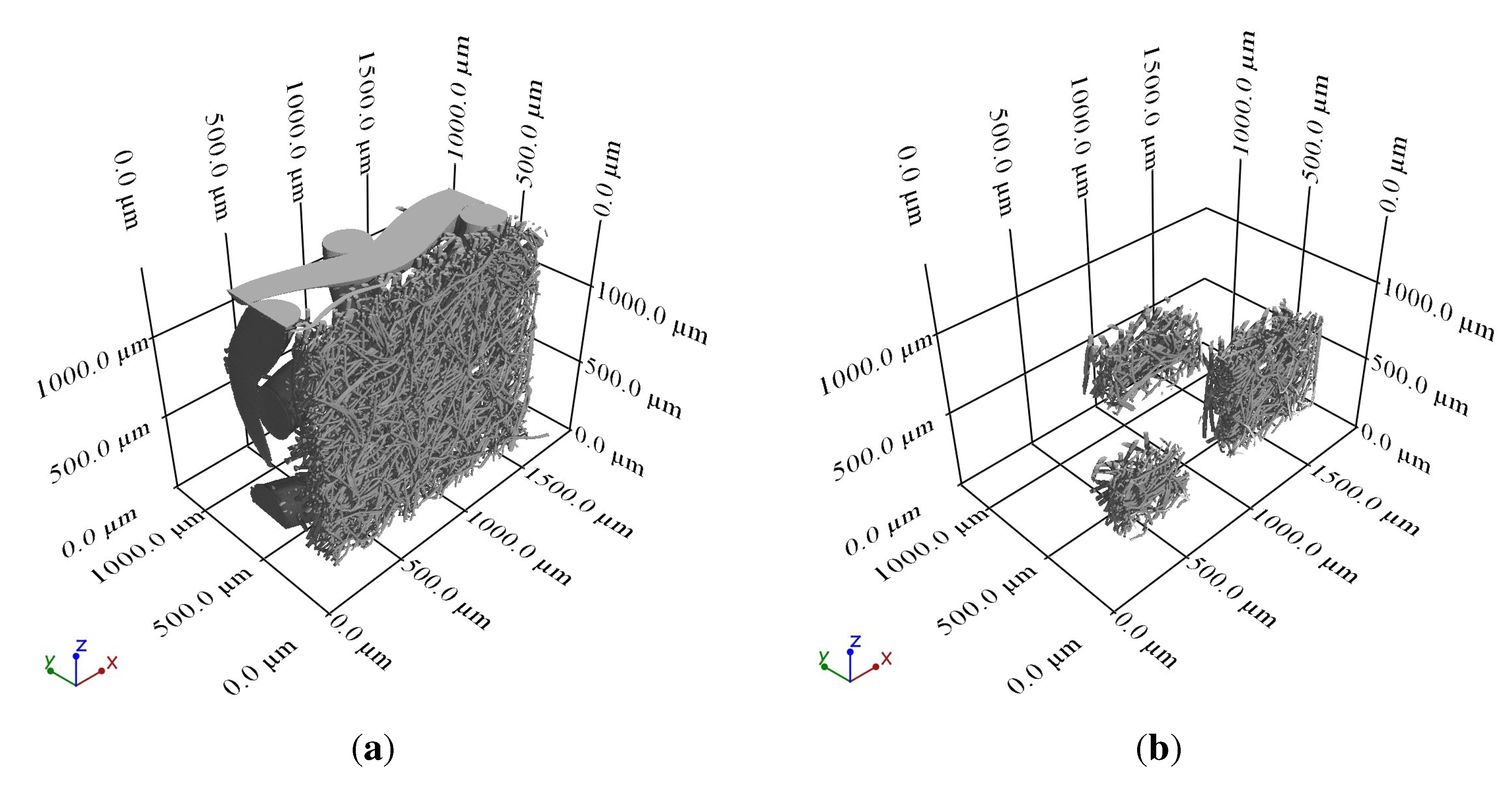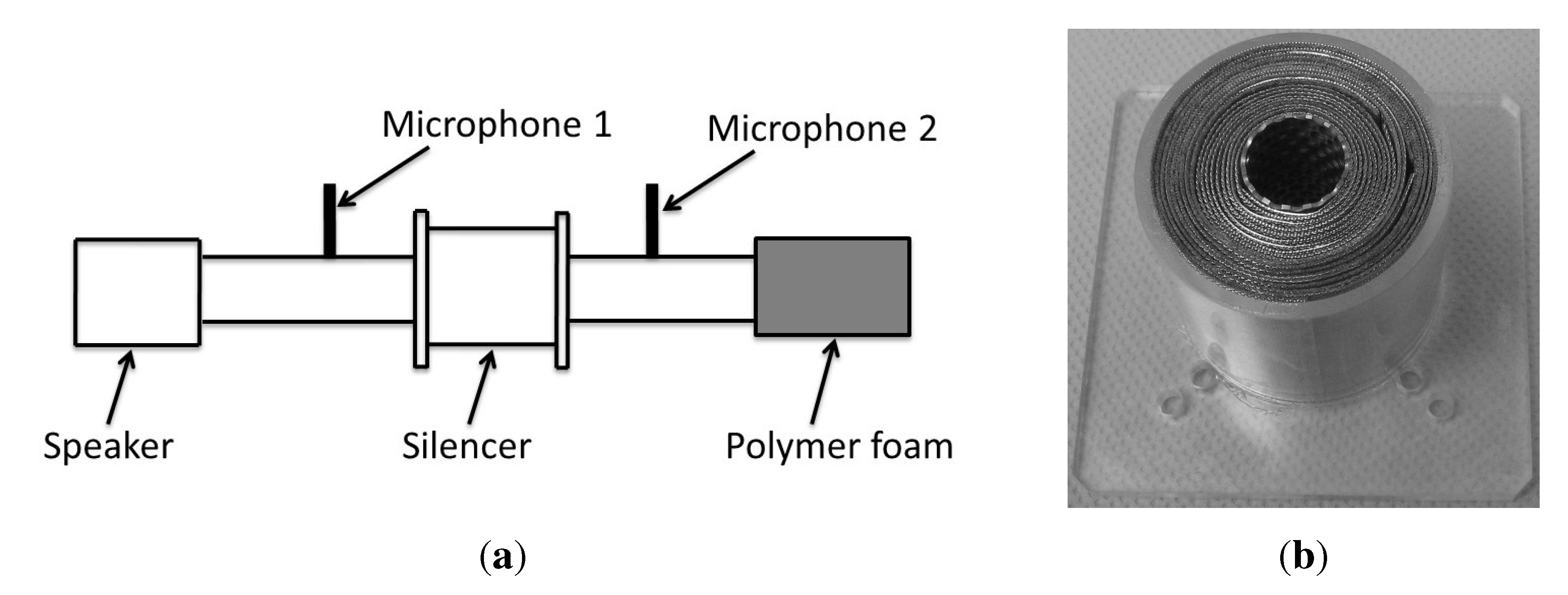Potential of Metal Fibre Felts as Passive Absorbers in Absorption Silencers
Abstract
:1. Introduction
1.1. Dissipative Absorption
1.2. Absorption Silencer
2. Material Characterisation

| Material | σ/% | t/µm | d1/µm | d2/µm | Ξ1/ kPas/m2 | Ξ2/ kPas/m2 |
|---|---|---|---|---|---|---|
| SFF 40 | 87 ± 19 | 280 | 13 ± 2 | 24 ± 2 | 182 | 127 ± 87 |
| SFF 50 | 86 ± 14 | 590 | 25 ± 2 | - | 79 | 90 ± 45 |
| SFF 70 | 92 ± 16 | 430 | 23 ± 2 | - | - | 33 ± 18 |
| SFF 100 | 92 ± 15 | 430 | 25 ± 2 | - | 85 | 28 ± 14 |
| SFF 120 | 89 ± 14 | 270 | 26 ± 2 | - | 95 | 49 ± 24 |
| SFF 150 | 94 ± 16 | 270 | 24 ± 2 | - | 37 | 16 ± 8 |
3. Attenuation Measurement



4. Discussion
5. Conclusions
Acknowledgements
References
- Haines, M.M.; Stansfeld, S.A.; Job, R.F.S.; Berglund, B.; Head, J. Chronic aircraft noise exposure, stress responses, mental health and cognitive performance in school children. Psychol. Med. 2001, 31, 265–277. [Google Scholar]
- Franssen, E.A.M.; van Wiechen, C.M.A.G.; Nagelkerke, N.J.D.; Lebert, E. Aircraft noise around a large international airport and its impact on general health and medication use. Occup. Environ. Med. 2004, 61, 405–413. [Google Scholar] [CrossRef]
- Bräunling, W.J.G. Flugtriebwerke,3.,vollst. überarb. u. erw. Aufl.; Springer: Berlin, Germany, 2009; pp. 1309–1314. [Google Scholar]
- Hinze, B.; Rösler, J.; Lippitz, N. Noise reduction potential of cellular metals. Metals 2012, 2, 195–201. [Google Scholar] [CrossRef]
- Seddeq, H.S. Factors influencing acoustic performance of sound absorptive materials. Aust. J. Basic Appl. Sci. 2009, 3, 4610–4617. [Google Scholar]
- Böswirth, L.; Bschorer, S. Technische Strömungslehre-Lehr-und Übungsbuch, 9. Auflage; Vieweg+Teubner, Springer Fachmedien Wiesbaden GmbH: Wiesbaden, Germany, 2012; pp. 175–177. [Google Scholar]
- Johnson, D.L.; Koplik, J.; Schwartz, L.M. New pore-size parameter characterizing transport in porous media. Phys. Rev. Lett. 1986, 57, 2564–2567. [Google Scholar] [CrossRef]
- Allard, J.F.; Atalla, N. Propagation of Sound in Porous Media: Modelling Sound Absorbing Materials, 2nd ed.; John Wiley & Sons, Ltd: Hoboken, NJ, USA, 2009; pp. 79–81. [Google Scholar]
- Schirmer, W. Technischer Lärmschutz-Grundlagen und praktische Maβ nahmen zum Schutz vor Lärm und Schwingungen von Maschinen,2.,bearbeitete und erweiterte Auflage; Springer: Berling, Germany, 2006. [Google Scholar]
- Sigloch, H. Technische Fluidmechanik Achte,überprüfte und aktualisierte Auflage; Springer: Berlin, Germany, 2012; p. 453. [Google Scholar]
- Möser, M. Technische Akustik,8.,aktualisierte Aufl.; Springer: Berlin, Germany, 2009; pp. 285–329. [Google Scholar]
© 2013 by the authors; licensee MDPI, Basel, Switzerland. This article is an open access article distributed under the terms and conditions of the Creative Commons Attribution license (http://creativecommons.org/licenses/by/3.0/).
Share and Cite
Lippitz, N.; Rösler, J.; Hinze, B. Potential of Metal Fibre Felts as Passive Absorbers in Absorption Silencers. Metals 2013, 3, 150-158. https://doi.org/10.3390/met3010150
Lippitz N, Rösler J, Hinze B. Potential of Metal Fibre Felts as Passive Absorbers in Absorption Silencers. Metals. 2013; 3(1):150-158. https://doi.org/10.3390/met3010150
Chicago/Turabian StyleLippitz, Nicolas, Joachim Rösler, and Björn Hinze. 2013. "Potential of Metal Fibre Felts as Passive Absorbers in Absorption Silencers" Metals 3, no. 1: 150-158. https://doi.org/10.3390/met3010150




